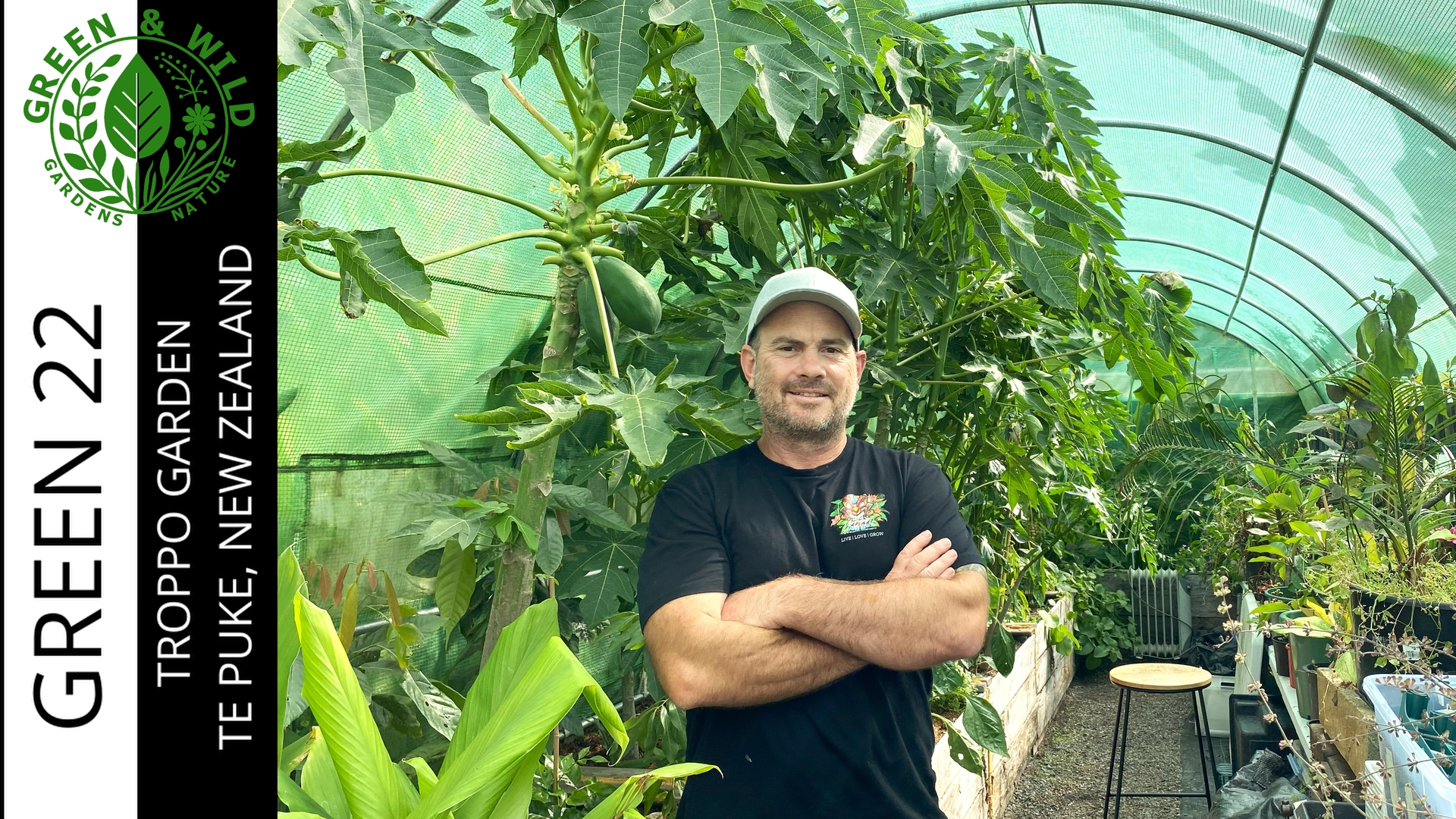It’s not every day that your passion project catches the attention of someone who shares your vision for a greener, more sustainable world. That’s exactly what happened when Bahareh from Green and Wild visited our Troppo urban tropical food forest and nursery in Te Puke. Her visit was more than a casual tour—it was a meeting of minds passionate about transforming urban spaces into lush, productive landscapes that nourish both people and the planet.
Bahareh, whose social media profiles introduce her as someone who takes viewers on “tours of stunning gardens and hidden paradises, sharing the stories behind their beauty,” was fascinated by our work. Through her lens, gardens become more than just collections of plants—they become stories of passion, perseverance, and the profound connection between humans and nature. Having Troppo become part of that narrative is an honor and an affirmation of our work in creating a living example of sustainable, community-focused growing.
The Troppo Experience: Food Security and Tropical Diversity
Troppo stands as a testament to what’s possible when permaculture principles meet innovative growing techniques. Nestled in Te Puke, often known as the kiwifruit capital, our food forest has evolved into something far more diverse and ambitious. As an initiative of Vector Group Charitable Trust, under their kai resilience and food security programs, Troppo demonstrates how urban spaces can be transformed into abundant, productive landscapes that support biodiversity while providing fresh, nutrient-rich food for the community.
What makes Troppo particularly special is our focus on tropical and rare plants that many wouldn’t expect to thrive in New Zealand. Our forest is home to a variety of exotic fruits, including bananas, papayas, cherimoyas, guavas, and even cacao. These plants showcase the potential of subtropical and tropical cultivation in New Zealand’s microclimates, challenging conventional thinking about what can be grown locally.
Inspired by natural forest structures, our food forest mimics the layered ecosystem of trees, shrubs, vines, groundcovers, and root crops. This design maximizes productivity while reducing maintenance needs, creating a self-sustaining environment that becomes more resilient over time. We’ve also implemented various growing techniques, from raised beds and syntropic agroforestry to hydroponic and greenhouse setups, which provides valuable insights into methods that can be adapted to different growing spaces and conditions.
Beyond being a showcase for tropical plants and innovative growing techniques, Troppo serves as a hub for community collaboration. We work closely with local groups to install raised garden beds, teach sustainable practices, and build kai resilience together. This community aspect resonated strongly with Bahareh, whose own work through Green and Wild emphasizes the human stories behind beautiful gardens and the connections they foster between people and nature.
Kai Resilience in the Bay of Plenty: A Growing Movement
The concept of kai resilience has taken root deeply in the Bay of Plenty region, with initiatives like Troppo forming part of a broader vision for food security and sustainability. At the heart of this movement is the Mana Kai Mana Ora initiative, which brings together sector experts to produce a comprehensive food security plan for the entire Western Bay of Plenty. Led by the Poutiri Charitable Trust, this ambitious project envisions that by 2030, Western Bay of Plenty communities will be kai secure and well-connected, ensuring all residents have access to fresh, nutritious, and culturally appropriate food regardless of circumstances.
During Bahareh’s visit, we discussed how food forests like Troppo represent a practical implementation of the principles outlined in the region’s food sovereignty plans. These living ecosystems demonstrate how communities can reduce dependence on imported produce, reconnect with the land, and build resilience against supply chain disruptions. In a world where food systems are increasingly vulnerable to climate change, economic fluctuations, and global crises, growing our own food has become more than just a hobby—it’s a crucial step toward community self-sufficiency.
The Western Bay of Plenty is witnessing an exciting expansion of food forests and feature gardens, with several new projects either underway or in the planning stages. A proposal for a Kai Resilience-Based Community Food Forest in Te Puke was recently submitted to the Western Bay of Plenty District Council, highlighting the growing recognition of food forests as valuable community assets. These initiatives are supported by a network of passionate individuals and organizations, including the Bay of Plenty Kai Resilience Network, which connects growers, educators, and food security advocates throughout the region.
Tropical Treasures: Rare Plants Thriving in Te Puke
One of the most captivating aspects of Troppo that drew Bahareh’s attention during her visit was our collection of rare and tropical plants that many wouldn’t expect to find flourishing in New Zealand. Walking through our food forest, her camera frequently paused to capture the unexpected sight of banana plants heavy with fruit, papaya trees reaching skyward, and the distinctive leaves of cacao plants—all thriving in our carefully created microclimate. These tropical treasures serve as living proof that with the right knowledge and techniques, we can expand our conception of what’s possible in local food production.
Among our rarest specimens are varieties of cherimoya, a delicious custard apple relative that produces creamy, sweet fruit with complex flavors reminiscent of banana, pineapple, and strawberry. We’ve also successfully cultivated several varieties of guava, including both the traditional tropical sweet guavas and the more temperate strawberry guavas that adapt particularly well to our climate. These aren’t merely curiosities; they represent practical additions to our local food system that can thrive with minimal inputs once established.
Beyond fruit-bearing plants, our collection includes rare medicinal herbs, unusual perennial vegetables, and edible flowers that add both beauty and nutrition to the food forest. Many of these plants serve multiple functions—attracting beneficial insects, improving soil health, providing natural medicine, and offering unique culinary ingredients. This multifunctionality is a core principle of permaculture design and contributes significantly to the resilience of our food forest ecosystem.
Growing Together Through Shared Passion
Bahareh’s visit to Troppo was more than just a feature for her Green and Wild channel—it was a meaningful exchange between kindred spirits passionate about the transformative power of gardens and sustainable food systems. As her camera captured the lush diversity of our food forest, we shared stories, knowledge, and a mutual excitement for the future of food resilience in our communities.
What makes Green and Wild such a valuable platform is Bahareh’s ability to see beyond the plants themselves to the human stories and ecological principles that give gardens their soul. Through her lens, viewers don’t just see beautiful landscapes; they gain insight into the philosophy, techniques, and dedication that create these living sanctuaries. Having Troppo featured on her channel offers an opportunity to share our approach to food security and tropical plant cultivation with a wider audience, potentially inspiring others to explore similar possibilities in their own communities.
We’re immensely grateful to Bahareh for shining her light on our little corner of paradise and helping to spread the message of food security and ecological diversity. As both Green and Wild and Troppo continue to grow and evolve, we look forward to further collaboration and mutual inspiration. After all, the journey toward more resilient, abundant, and connected communities is one best traveled together, with cameras rolling, hands in the soil, and hearts open to the beauty and potential of our shared natural world.



